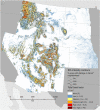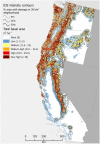Denser forests across the USA experience more damage from insects and pathogens
- PMID: 36871063
- PMCID: PMC9985637
- DOI: 10.1038/s41598-023-30675-z
Denser forests across the USA experience more damage from insects and pathogens
Abstract
Forests across much of the United States are becoming denser. Trees growing in denser stands experience more competition for essential resources, which can make them more vulnerable to disturbances. Forest density can be expressed in terms of basal area, a metric that has been used to assess vulnerability of some forests to damage by certain insects or pathogens. A raster map of total tree basal area (TBA) for the conterminous United States was compared with annual (2000-2019) survey maps of forest damage due to insects and pathogens. Across each of four regions, median TBA was significantly higher within forest areas defoliated or killed by insects or pathogens than in areas without recorded damage. Therefore, TBA may serve as a regional-scale indicator of forest health and a first filter for identifying areas that merit finer-scale analysis of forest conditions.
© 2023. This is a U.S. Government work and not under copyright protection in the US; foreign copyright protection may apply.
Conflict of interest statement
The authors declare no competing interests.
Figures





References
-
- Teale SA, Castello JD. The past as key to the future: a new perspective on forest health. In: Castello JD, Teale SA, editors. Forest Health: An Integrated Perspective. Cambridge University Press; 2011. pp. 3–16.
-
- North MP, et al. Operational resilience in western US frequent-fire forests. For. Ecol. Manag. 2022;507:120004. doi: 10.1016/j.foreco.2021.120004. - DOI
-
- Raffa KF, et al. A literal use of “forest health” safeguards against misuse and misapplication. J. For. 2009;107:276–277.
Publication types
MeSH terms
LinkOut - more resources
Full Text Sources

